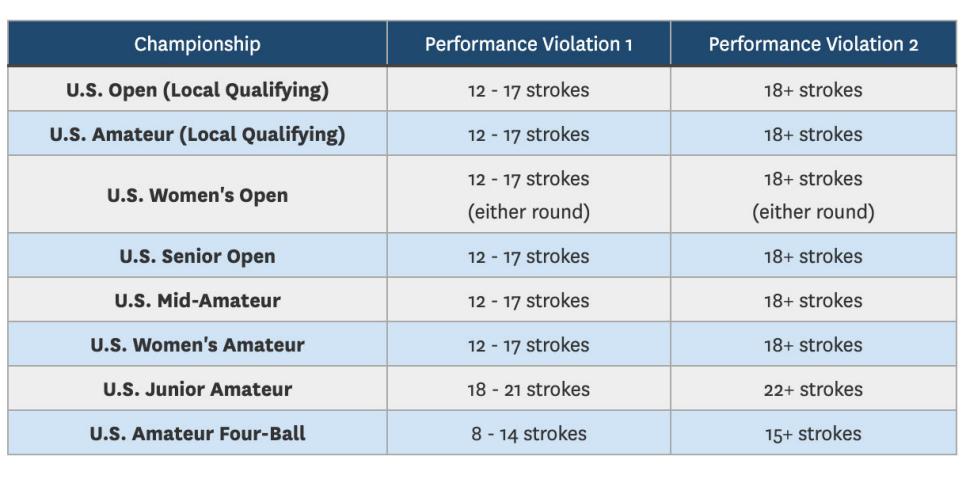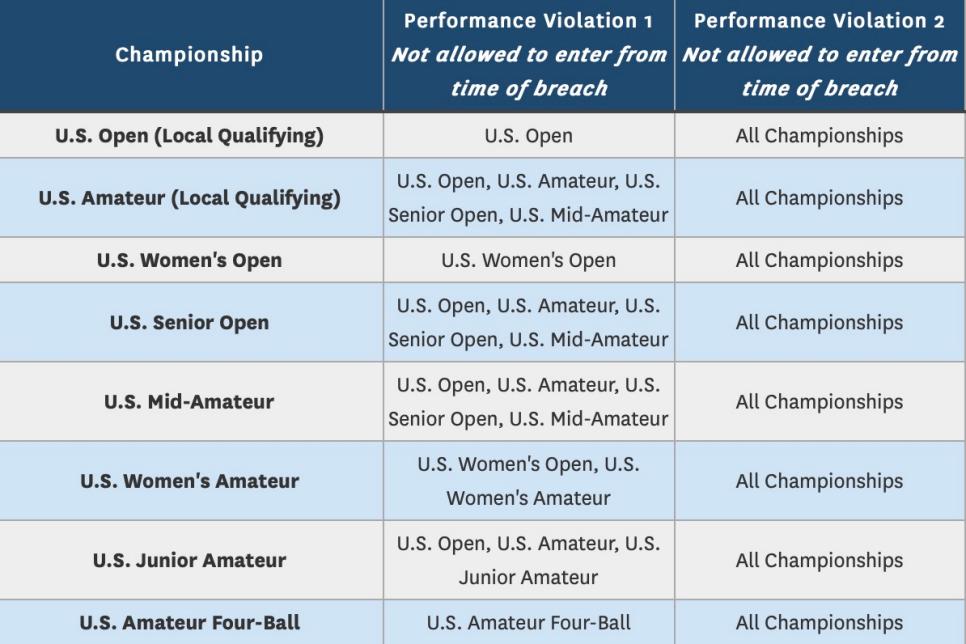I was sick. I had just gotten a lesson. I was busy with college final exams. My girlfriend was caddieing for me.
These were just some of the lame excuses that came to mind six years ago when I received a letter from the USGA informing me that because of my poor performance in U.S. Open local qualifying, I needed to submit appropriate tournament scores or risk future suspension from qualifying.
“It has been brought to the USGA’s attention that during local qualifying for the 2018 U.S. Open, you failed to return a score within eight strokes of the USGA Course Rating or failed to return your score card,” the email said. “Therefore, the USGA respectfully requests that you submit information to substantiate your ability to play at the national championship level.
“If we do not receive a response with sufficient documentation, a future entry for the U.S. Open may be declined.”
RELATED: What would you shoot at the U.S. Open? New USGA tool settles a common debate
Forget the excuses, I just played poorly, made a bunch of bogeys and shot 84 at Great River Golf Club in Milford, Conn., a very nice course that I haven’t been back to since.
When I received the email warning a few months later, I was initially defensive and bitter. I had just finished my freshman year of Division I college golf, and I received the email just days after a top-four finish in my state amateur. Yes, it was a terrible round, but doesn’t the USGA understand that bad days happen?
As you might expect, I missed many greens and was scrambling all day en route to my 84 in 2018 U.S. Open qualifying.
Portland Press Herald
What I didn’t appreciate is that the USGA’s performance policy, instituted at eight of its 15 championships, is essential to the integrity of the qualifiers.
This performance policy has taken numerous forms over the years and was most recently updated in 2024. Put most simply, if you shoot above a predetermined score at certain USGA qualifiers, you will receive a letter and be asked to submit other tournament scores demonstrating your ability. If you fail to do so, you will be prevented from entering certain USGA qualifiers.
Though the specifics of the policy have changed in recent years, its justification has remained the same. “The impetus for the performance policy is first and foremost to ensure that the players competing and qualifying are players that really can compete at a national championship level,” says Brent Paladino, the USGA’s senior director of championship administration.
More Golf Digest U.S. Open Coverage  Mixed Messages U.S Open 2024: Does the USGA have an obligation to make America’s golf meccas more accessible?
Mixed Messages U.S Open 2024: Does the USGA have an obligation to make America’s golf meccas more accessible?  Golf Digest Logo My 11 favorite Pinehurst courses, ranked
Golf Digest Logo My 11 favorite Pinehurst courses, ranked  Viewer’s Guide U.S. Open 2024: How to watch, TV times, streaming options, featured coverage from Pinehurst No. 2
Viewer’s Guide U.S. Open 2024: How to watch, TV times, streaming options, featured coverage from Pinehurst No. 2
That goal is important for two main reasons, Paladino says. “No. 1 would be the experience for all the players at qualifying,” he says. “If you’re paired with someone that’s shooting 90 or 100, that could really impact your experience at the qualifier, right?”
Secondly, in recent years post COVID, qualifying sites for many USGA championships are filling within minutes of entries opening. Therefore, it’s essential that the right players—those capable of qualifying—have those limited spots, not golfers who aren’t ready for national competition.
As for the specifics of the current policy, if you return a score between 12 and 17 strokes greater than the course rating in qualifying for certain championships, including the U.S. Open, U.S. Amateur and U.S. Women’s Open, then you will be placed on the “Performance Violation 1” list. Two championships, the U.S. Junior Amateur (more lenient) and the U.S. Amateur Four-Ball (more strict) have slightly different thresholds.

When you are placed on this list, you will receive an email from the USGA asking for you to submit appropriate tournament scores from local, state or national tournaments from the last two years. To get off the Performance Violation 1 list, you must submit a minimum of three multi-round individual tournaments with either:
- An average score of 77 or lower
- Average score within five strokes of the course rating
- Average score within five strokes of your listed handicap
A member of the USGA will review your submission and if you meet these criteria, you will be removed from the list and allowed to enter qualifying for any championships that you are otherwise eligible for. If you don’t respond or do not submit the required scores, then you will not be allowed to enter certain USGA championships indefinitely. (The specific championships that you are suspended from varies.)

If you are on a Performance Violation list with the USGA, you will be prevented from entering certain championships.
Courtesy of the USGA
If you shoot a qualifying score more than 18 strokes above a course rating, then you will be placed on the Performance Violation 2 list, which works a similar way, though requires five tournaments worth of scores, not three.
This new policy, Paladino says, is more transparent and objective than previous ones. In the past, if you shot a high score at a qualifier, you would submit scores and USGA officials would review them using their own discretion, which was a subjective process.
Now, players can more quickly and clearly get off the list and resume USGA qualifying. “We certainly don’t want it to be like a scarlet letter where you’re banned forever,” Paladino says. “We all understand that bad rounds happen.”
How common are these performance violations? As entries have increased across each of the USGA’s championships in recent years, so too has the number of violations, Paladino says.
RELATED: Everything you need to know about the 2024 U.S. Open at Pinehurst No. 2
This year, about 9,500 players competed in U.S. Open local qualifying. “About 1,000 will receive some sort of letter from us, so it’s not an insignificant amount,” he says. “It’s certainly a process that we take very seriously to ensure that we’re sending them to the right players.”
More Golf Digest U.S. Open coverage  Why not you? A complete guide to qualifying for a USGA championship (or any other competition)
Why not you? A complete guide to qualifying for a USGA championship (or any other competition)  U.S. Open 2024 ‘A new day’: USGA President Fred Perpall brings dynamic personality and drive to golf
U.S. Open 2024 ‘A new day’: USGA President Fred Perpall brings dynamic personality and drive to golf  Golf Digest Logo Losing vs. Failing: Why every golfer needs to know the difference
Golf Digest Logo Losing vs. Failing: Why every golfer needs to know the difference
Though the specific numbers are still being worked through, Paladino estimates that around half of those 1,000 players will respond to the USGA’s letter and submit scores. Of those, Paladino says about half will be immediately cleared, and the other half will need to resubmit scores for various reasons.
Selfishly, I was a little relieved to hear that 1,000 players receive letters after U.S. Open qualifying. I even tossed the statistic to my coworkers to try and show that my round wasn’t that bad. The USGA’s policy is simultaneously—and intentionally—unforgiving and forgiving. It’s not that hard to get a letter, but it’s easy to be quickly reinstated.
“We’ve had everyone, even past USGA champions be on this list, so we look at it and see that this player clearly just had a rough day, and you can clear them immediately,” Paladino says.
As for me, my high score at Great River served as a spark of great play that summer. When I received the letter in July, I begrudgingly submitted my scores and was cleared within a few days. My next USGA qualifier was a couple months later, for the U.S. Amateur Four-Ball Championship, which was to be played the following spring at Bandon Dunes.
I qualified alongside a college teammate. I wasn’t sick, hadn’t gotten a lesson, I didn’t have any final exams and my girlfriend wasn’t caddieing for me.

All ended well for me in USGA qualifying in 2018, when a college teammate, Chuck Isgar, and I successfully qualified for the U.S. Amateur Four-Ball Championship.
This article was originally published on golfdigest.com

